Barcelona is a true treasure trove of stunning architectural wonders by some of the world’s most renowned architects. Intricately designed by the legendary architect Antoni Gaudí, Sagrada Familia is a Barcelona landmark you just can’t afford to miss. Any trip to the Catalan would be incomplete without a visit to the world’s largest unfinished church. With over 3 million visitors every year, there are a plethora of Sagrada Familia tickets on offer and each of them gives you a unique perspective of the Roman Catholic basilica.
It is mindblowing to even imagine that Sagrada Familia Barcelona has been under construction for the last 136 years. This unique feature in itself is a testament to its grandeur and glory. This is our comprehensive guide to exploring Sagrada Familia ticket options, architecture, interiors, and other tips and hacks for your Sagrada Familia visit.
Sagrada Familia Barcelona
Essential Information

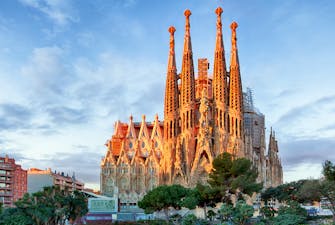
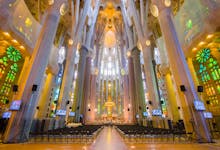
Things to know
☀️ Best time to visit - early mornings
⏰ Suggested duration - 2 Hours
🎟️ Starting Sagrada Familia Guided Tour price - €49
📐 Architecture Style - Spanish Late Gothic, Catalan
Modernism or Art Nouveau
📏 Height - 172 meters
Quick Facts
• Also Known As: Basílica i Temple Expiatori de la Sagrada Família (Catalan) and Templo Expiatorio de la Sagrada Familia (Spanish)
• Construction began: 1882
• Estimated date of completion: 2026
• Architect: Antoni Gaudi
• Architectural style: Modernisme
• Number of visitors per year: 2.5 million
Must See
Nativity Facade
Passion Facade
The Towers
Crypt
Sagrada Familia Ceiling
Beautiful stained-glass windows
Opening Hours
Monday to Thursday - 9 am to 6 pm
Fridays - 9 am to 2 pm
Weekends - 9 am to 3 pm
Address
Carrer de Mallorca, 401,
08013 Barcelona, Spain
Get There
What makes the Sagrada Familia Church special?
Sagrada Familia, is an architectural gem in Barcelona’s sprawling skyline, a reflection of the prodigal Catalan architect Antoni Gaudi’s distinct imagination and style. The sublime beauty of Sagrada Familia transcends the layers of Catalonia’s rich cultural history and in the words of Gaudi himself, “The temple as a whole, as well being a place for divine worship, will artistically represent the truths of religion and the glorification of God and His Saints.”
The ornamental beauty of this towering structure originates from the striking synergy between Christian iconography and Gaudi’s unique form that is inspired by the patterns he found in nature. The colourful stained glass panes that run in harmony with the delicate carvings which adorn the Church’s façade, are a fine example of Art Nouveau and Catalan Noucentisme architecture.
Inspired by the mores of Gothic and Byzantine cathedrals, the foundation stone for Sagrada Familia was laid over a century ago in 1882, and 135 years later, this iconic monument is still a decade away from completion. The complexity of this massive structure lies in its design, and creating this masterpiece to its last detail requires enormous funding, the lack of which, has slowed the realisation of this dream-like structure.
History
The ongoing history of Sagrada Familia Barcelona

Everything starts from humble beginnings. So was the ideation of Basílica de la Sagrada Família. It was the inspiration of a bookseller, Josep Maria Bocabella, who later became the founder of the Spiritual Association of Devotees of St. Joseph. On his return from the Vatican City in 1872, Joseph intended to build a church inspired by the basilica at Loreto. Little did he know that his humble idea would become something legendary.
He gathered donations not long after and appointed architect Francisco de Paula del Villar to take charge. Villar’s plan was to build a standard form of Gothic revival church. Following the resignation of Villar in 1883, Antoni Gaudi began to work on the project as chief architect. Gaudi’s desire was to raise the standard to grandeur. The construction of the church took an extremely long time to complete. Antoni Gaudi passed away in the year 1926, while the construction was only 15 - 25% complete. As a matter of fact, it was far from complete. Many parts of the unfinished basilica along with Gaudí's models were destroyed during the Spanish Civil War in 1936.
Since, it took several great architects, time and persistence to get to the marvel of Sagrada today. As for the Sagrada Familia finish date, it was said that the construction would be complete by 2026, the 100th anniversary of Antoni Gaudi's death. Sadly, it is difficult to say for sure since the current pandemic has delayed development.
Sagrada Familia History - A Timeline
1882: March 19, First stone was laid on Saint Joseph's Day based on designs drawn by Francisco de Paula del Villar y Lozano.
1884: Antoni Gaudí officially took over as the principal architect.
1892: Foundation of the Nativity façade was laid.
1925: November 30, The first bell tower in the Nativity façade, dedicated to St. Barnabas was completed.
1936: Original plans were lost and many parts of the structure were burned down due to military uprising and the outbreak of the Spanish Civil War.
1955: Fundraising drive for the construction began and has continued ever since.
2000: Foundation of the Glory façade was laid to mark the new millennium.
2010: Sagrada Familia was consecrated as a place of worship by Pope Benedict XVI.
2018: Close to 70% of the Basilica has been constructed.
Sagrada Familia Architecture
What makes Gaudi's architectural wonder stand out?
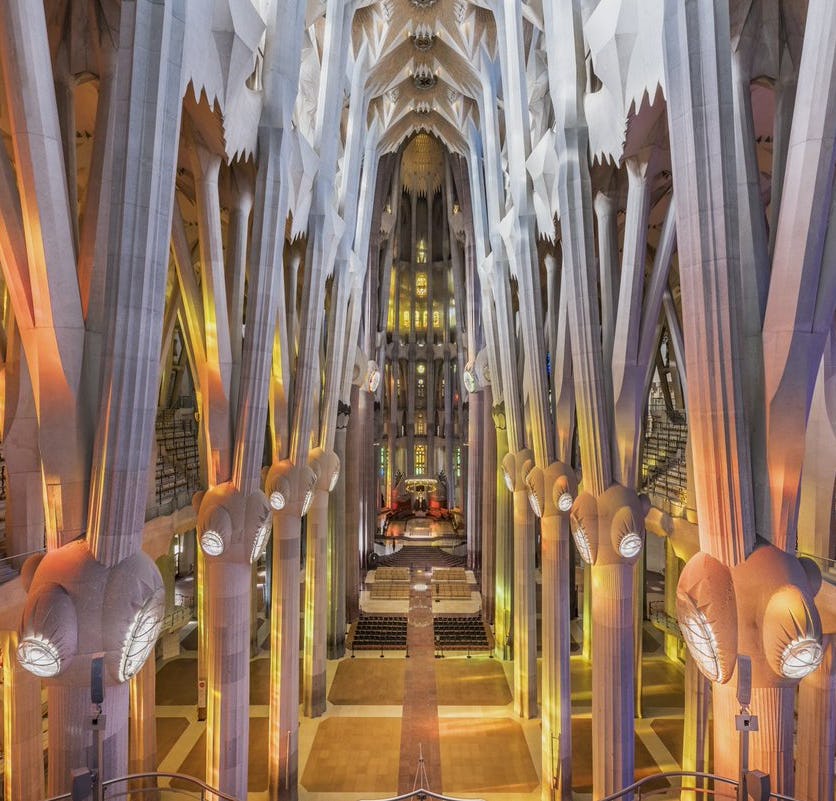
Antoni Gaudí envisioned Sagrada Familia along the lines of Gothic and Byzantine places of worship with the motif of imparting the message of the Evangelists through architecture. Its planned 18 towers represent the Apostles, the Virgin Mary, the Gospels, and Jesus Christ, and symbolize an ascension towards God. The Basilica was planned by Gaudí so as the let the reflected sunlight illuminate various aspects of Christ's life.
Antoni Gaudí believed that man-made structures should never try to upstage God's creations. Consequently, Sagrada Familia is one meter shorter than Montjuïc Hill, the highest point in Barcelona. After his death, his plaster models have shown the way to craftsmen. The geometrical sense that has been imparted to the megastructure alludes to Cubist and Art Nouveau themes. There is an apparent influence of nature in the architecture of Sagrada Familia, in the complete absence of straight lines in the whole structure.
The Interiors & Facades of Sagrada Familia
Antoni Gaudi envisioned Sagrada Familia along the lines of Gothic and Byzantine places of worship, with the important aim of imparting the message of the Evangelists through architecture.
Its initially planned 18 towers represent the Apostles, the Virgin Mary, the Gospels, and Jesus Christ, and symbolize an ascension towards God.
The Basilica was planned by Gaudí so as to let reflected sunlight illuminate various aspects of Christ's life inside the Sagrada Familia.
Compared to the Nativity facade, the Passion facade sports a rather unembellished look as Antoni Gaudi wanted to dedicate it to the suffering of Jesus during his crucifixion. To drive home this message, the facade is situated in the west and faces the sunset.
The bone-shaped columns symbolize the death of Christ and the sins of Mankind.
The scenes sculpted on this facade depict Christ's last night, the Calvary of Christ, and finally, the burial and resurrection of the savior Jesus. The Passion facade also has four towers that were completed in 1976.
The Glory facade is the largest and the most elaborate of the three façades. Antoni Gaudi intended the principal facade to symbolize the celestial glory of Christ.
The elements of Death, Final Judgement, Hell, and Glory can be found in the Glory facade. The columns in the portico depict The Seven Deadly Sins at its base and The Seven Heavenly Virtues at the top.
Construction of the Glory facade began in 2002, and it’s speculated that the demolition of the buildings in the adjacent block might be required for its completion.
Just like the facades, every part of the interiors of Sagrada Familia has its symbolic meaning. Sagrada Familia has five naves. The central nave rises above the others. Each nave has a door that leads to the Glory façade.
Antoni Gaudí's naturalistic influence is apparent in the inclined tree-like branched formation of the columns, which give the interiors a unique woodlands feel. The design enables each column to support multiple weight point and creates large vaults through which sunlight can stream in.
Shaped like a colossal Latin cross, Sagrada Familia measures 90 meters from the entrance to the apse. Immediately after finishing the crypt, Antoni Gaudí concentrated on the apse. Seven chapels and two staircases flank the apse. There is an elaborate organ, consisting of 8000 pipes, behind the altar.
The Crypt at Sagrada Familia is the oldest part of the Church constructed in Neo-Renaissance style with mosaic floors depicting luscious vines, columns that are richly decorated with roots, leaves, and branches. Antoni Gaudi is buried in the Crypt ( to the left of the main altar).
Sagrada Familia Museum
A treasure trove of Gaudi’s knowledge
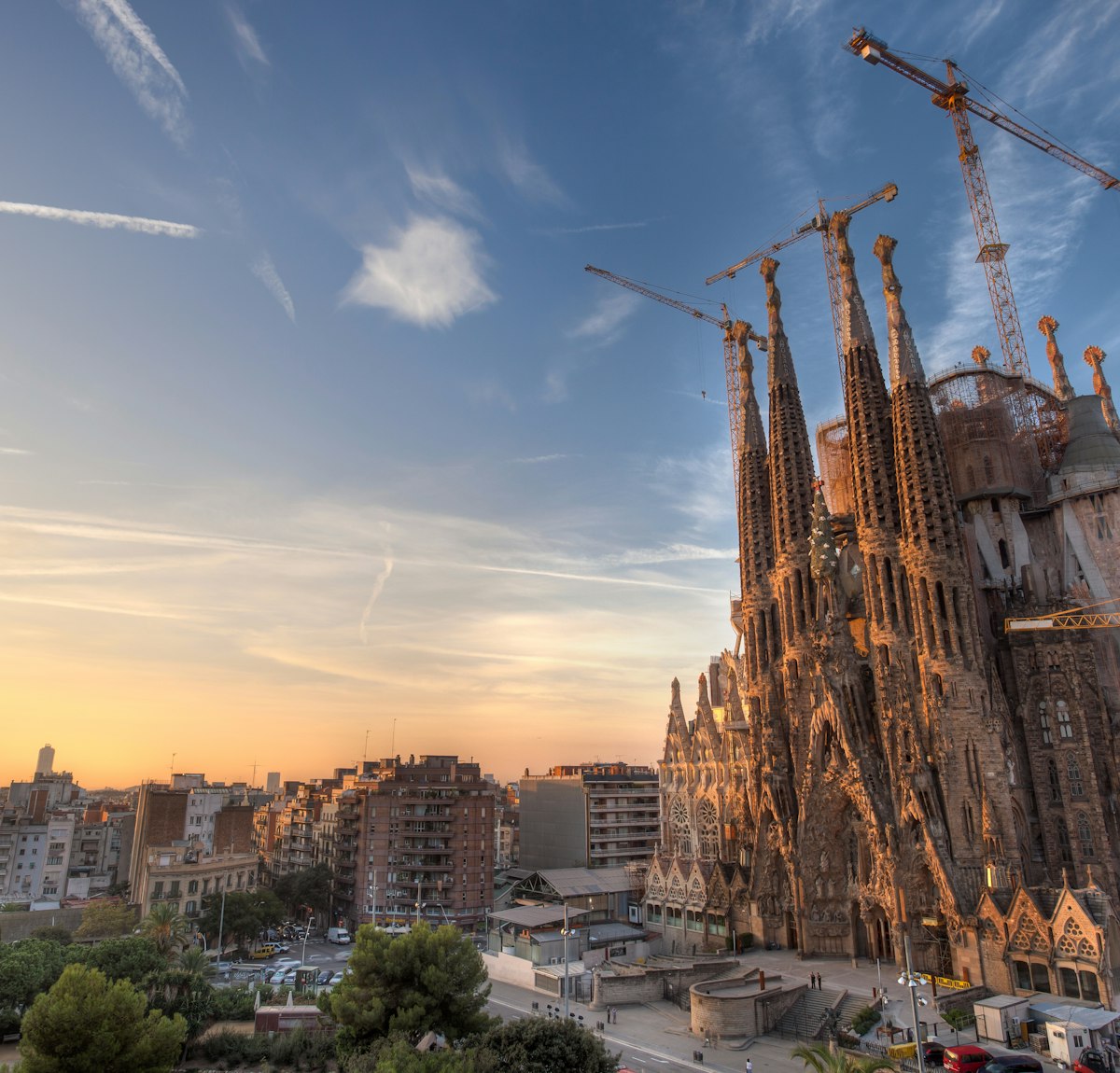
The Museum is situated on the ground floor of the Sagrada Familia Church built by Gaudi. The now world-renowned museum was opened in 1961 at the location where the workshops used to be during the church’s construction.
Inception of the Museum
It has quite a history associated with it. The death of Gaudi was a blow to architecture as the world knew it. A number of Gaudi’s followers pointed out the need to create a place where his work would be conserved and disseminated. The immediate way to do so without disrupting anything was adapting the workroom located in the building site itself. This was because space played host to all of Gaudi’s manual craftwork, from the scale models of the church to the carvings.
However, the refurbishment work proved fruitless as the church was attacked during the Civil War. Most of the workroom, including the scale models, plans and drawings, were destroyed.
However, this opened the eyes of quite a few historians and architects and they understood why preserving Gaudi’s work was important. The workroom was soon reconstructed and displayed.
The First Museum was under Passion Facade
In 1961, when the museum first opened, it was the basement underneath the Facade of the Passion. It was later moved to its current location, which is a much larger and suitable space to accommodate the sea of visitors. The museum showcases drawings, period photographs, ceremonial furniture and a number of scale models that are copies of Gaudi’s originals. You will also be able to see the model workshop where Gaudi’s original models are being restored.
How To Make The Best Of Your Sagrada Familia Tour?
The monument is very popular among tourists. Evidently, you need to know a few tricks to make the best use of your time.
- Start off by securing Skip the Line Sagrada Familia tickets. Albeit they may cost a little more, you spend less time waiting, and more exploring. There is a sea of information to know about Sagrada Familia .
- Go for the Sagrada Familia guided tours to get better insights into this superstructure. Once you see Sagrada Familia with your own eyes, you will sense the shutterbug in you come to the fore.
- Visit the place during sunset to click great photos and witness the monument's unique charm in the twilight.
- Unlike other attractions in Barcelona, Sagrada Família remains open on Mondays. Everyone thinks it is shut,hence not many people visit Sagrada Familia on Monday. Plan your visit on a Monday and you'll be surprised to see the sparse crowds!
- Within Sagrada Familia , the most curious structure is possibly the crypt. Do not give this UNESCO accredited site a miss.
- One of the important features of Sagrada Familia is the towers. Get separate tickets to go up the Sagrada Familia towers and relish the breathtaking view of the city.
- Finally, if you are genuinely interested in the structure, keep at least 3 hours aside for a sedate tour of the entire precinct of Sagrada Familia.
Sagrada Familia Tickets
Compare & choose the right Sagrada Familia tickets
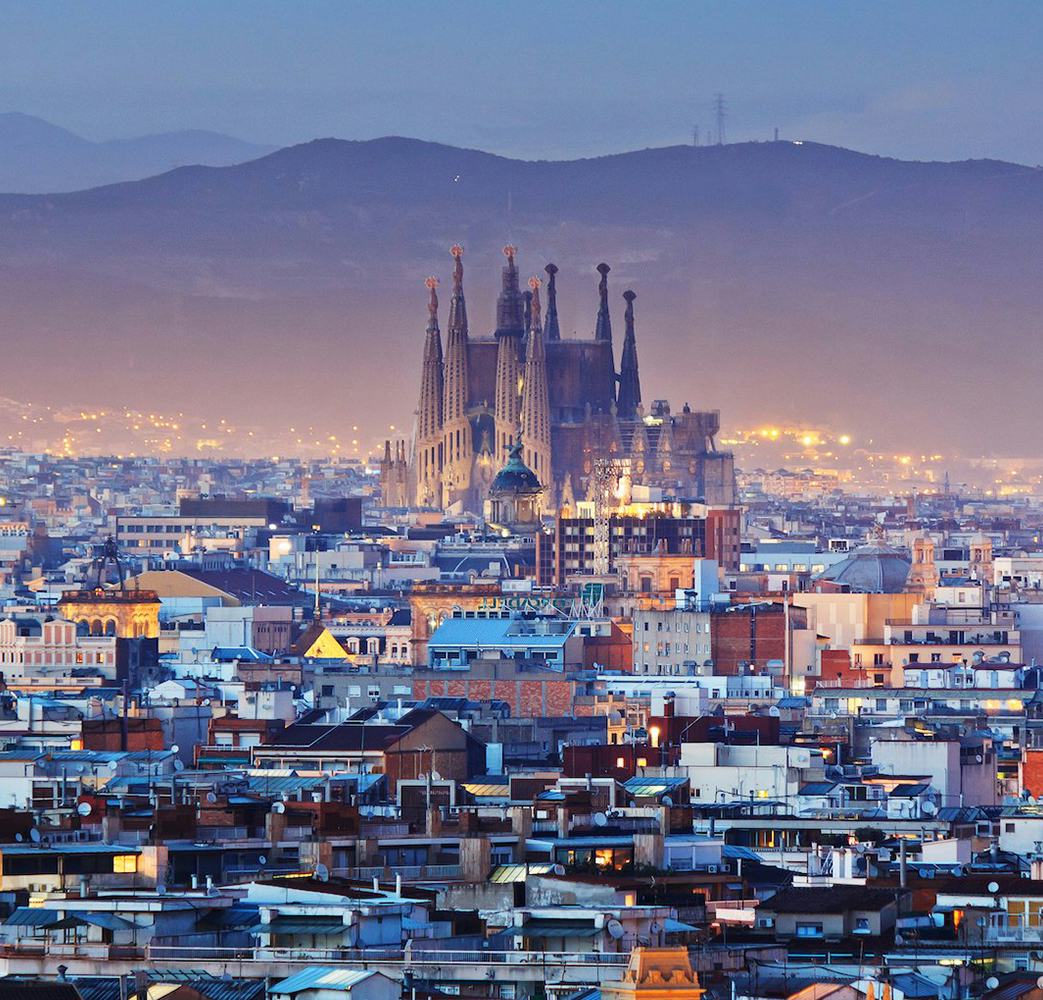
When it comes to experiencing Sagrada Familia and its grandiose, there are quite a few types of Sagrada Familia tickets to choose from. From Skip The Line tickets and Sagrada Familia Tower Access to Park Guell combo packages and Sagrada Familia Guided Tours, you are guaranteed to find a carefully curated experience perfect for you.
There are 3 major types of Sagrada Familia Tickets - Skip The Line Tickets, Sagrada Familia Tower Access Tickets, and Sagrada Familia Guided Tours.

Visit Barcelona’s most sought-after attraction with fast track tickets that allow you seamless entry into the most breathtaking basilica in the Catalan city.
Save yourself up to 2 hours in ticket queues and explore Antoni Gaudi's prized creation for as long as you wish. You can admire the facades and towers from the outside, but access to the towers is optional.

With these tickets, you can climb to the top of either the Nativity or Passion facade tower, for a closer look at the intricacies of the facade and unparalleled views of the Catalan city.
You'll also get Skip the line entry to the Sagrada Familia. You can whizz past ticket queues and explore the grand Basilica with an audio-guided tour in your preferred language.
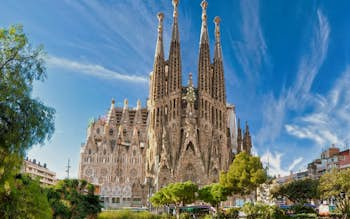
Explore the iconic Barcelona landmark on a 2-hour guided tour with an expert local guide. With an expert guide, you will not only be able to find and see the most beautiful sections of the church but also get context and insight into Gaudi’s creations.
Depending on your ticket, you can visit the Passion or Nativity Tower and end your tour with a visit to the Sagrada Familia Museum.
1. Sagrada Familia Skip The Line Tickets - Fast Track Access
Being one of the top attractions in Barcelona, Sagrada Familia is usually swarming with visitors and ticket queues are often hours long. With Sagrada Familia Fast Track tickets, you can Skip the Line at the ticket counter and get priority access to the Basilica entrance.
Once at the entrance, you can zoom past waiting lines to the inner sanctum of the magnificent basilica and enjoy breathtaking views of the facades, interiors, and exterior walls, complete with eye-catching, complex designs by Gaudi. Though Sagrada Familia Tower Access is not included with these tickets, you can choose to upgrade your ticket to get access to either the Nativity or Passion facade tower.
2. Sagrada Familia Fast Track Tickets With Tower Access
The main highlight of Sagrada Familia Fast Track With Tower Access ticket option is that it gives you the option to scale one of the cathedral's sky-high spires - Nativity or Passion. After exploring the sanctum, you can choose to climb either one of the towers and soak in unparalleled views of the Barcelona skyline.
With fast-track tickets that you can book online, you don’t have to worry about long winding queues and get guaranteed access to an otherwise sold-out attraction. You can enjoy breathtaking views of the facades, interiors, and exterior walls.
You can choose to go up the spire on the Nativity Facade and get views over the east of Barcelona, or the tower of the Passion Facade that faces the city center. Lift access is also included with the tickets.
3. Guided Tours of Sagrada Familia with Tower Access
To truly enjoy the mesmerizing work of Gaudi, you need to learn about the symbolism embedded in each architectural piece. With a guided tour of Sagrada Familia with Tower Access, you will not only be able to find and see the most beautiful sections of the church but also get context and insight into Gaudi’s creations.
You can often get lost in the vast cathedral and miss out on the highly sought-after experience - Sagrada Familia Tower Access. Since the Nativity and the Passion Facades are not joined, the access points to these spires are different. With a guided tour, you will not have to wander around and search for access points as the guide will lead you to the most easily accessible tower lift.
Related Read: 5 tried & tested hacks to Skip the lines at Sagrada Familia.
Sagrada Familia Guided Tours
Which La Sagrada Tour should you go for?
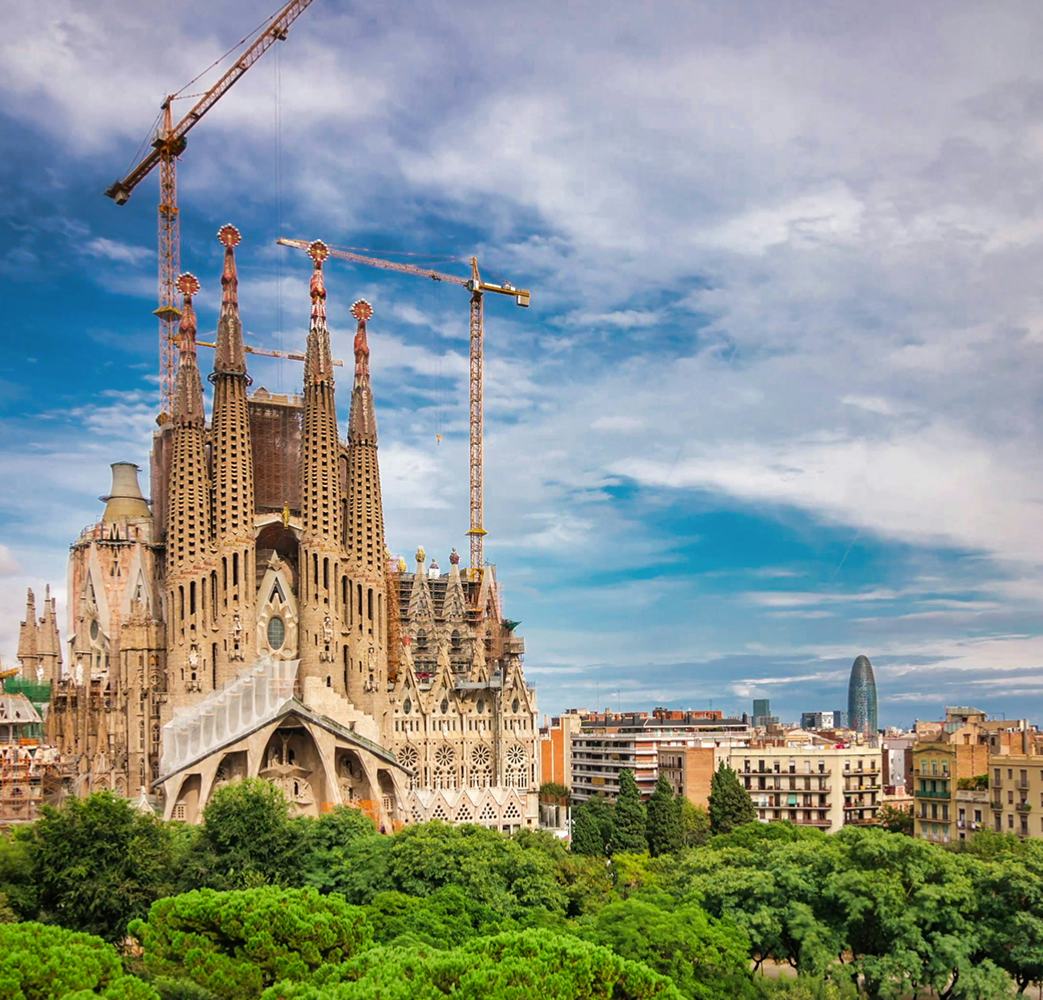
Due to the sheer number of visitors that it attracts, visiting the gargantuan basilica can be quite daunting, especially if it is your first time in the country. From waiting in line for hours to finding your way around the towers, it can become quite a time-consuming experience. An easy way to avoid this problem is to opt for a guided tour of the Sagrada Familia. Your expert guide will take care of everything, from finding a convenient time to planning the trip in detail. With Sagrada Familia guided tours are your best bet for an easy and hassle-free experience.
No more crowded ticket lines
Being one of the most visited attractions of the city, Sagrada Familia attracts hundreds of visitors every day. By choosing a Sagrada Familia guided tour, you can save a lot of time that can be spent in admiring the beauty of the Catalan city. Being part of a guided tour allows you to enter through a different gate (Group Entrance) with lesser waiting time than the standard one.
Flexible timings
Sagrada Familia during sunset is a spectacular sight to behold. With the light from the setting sun reflecting across the numerous color-stained glass windows, the basilica is covered with a golden hue. It is interesting to note that Gaudi designed the basilica to let sunlight light up different aspects of Jesus Christ’s life. However, since this is the most popular time slot, you will have to deal with long queues and crowded ticket counters. By opting for a Sagrada Familia sunset guided tour, you can enjoy the golden hour to its fullest, without having to worry about crowded lines.
Expert guidance
The best way to truly unveil the intricate features of the iconic landmark is by opting for a guided tour of the basilica. You will be able to see and understand the symbolism of nature and secret corners embedded in Sagrada Familia. Your professional guide will answer all your questions and make sure that you make the most of your visit.
La Sagrada Familia Towers
Nativity Tower vs Passion Tower
Sagrada Familia towers are a spectacle to watch from the outside and offer a mesmerizing journey through history from the inside. While Sagrada Familia tickets with Tower Access are slightly more expensive, exploring the two Sagrada Familia towers open to the public is an experience that you just can’t forgo.
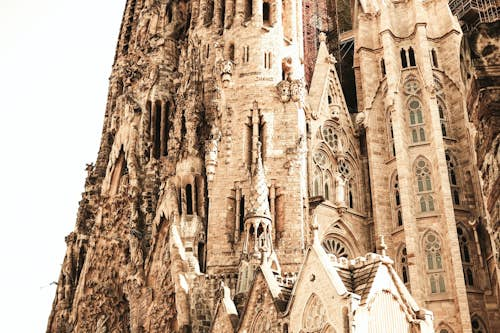
Waiting Times: Passion Tower is the lesser crowded of the two towers open to public. If you are on a time-bound trip and are just looking to experience Gaudi’s spell-binding work, Passion tower is your go-to option. However, if you’re looking to dive into the master crafter’s architectural prowess, you should not miss exploring the Nativity Facade.
Architectural Style: While the tower was designed by Gaudi, it wasn’t made by him. Nevertheless, Gaudi’s disciples and apprentices carried on his work and has done a brilliant job at actualizing Gaudi’s vision of the Passion Tower.
Bridges: None of the Passion Towers are connected by bridges yet.
Construction Status: Passion Towers will only offer you unobstructed views in the presence of construction equipment as it is still under construction. If you are a casual visitor looking to just experience one of the towers, Passion Tower is your go-to option.
Stairways: According to a majority of visitors, the stairs of Passion Towers are narrower than that of Nativity, Hence, it is not recommended for claustrophobic people and visitors scared of climbing down 504 narrow stairs.
Balcony Access: Though it does feature stairs, unfortunately, Passion Towers do not have this feature as of yet.
Photographs: If you’re a professional photographer looking to click marvelous pictures of Sagrada Familia or the Catalan city, Passion Towers is not for you. This is because the Passion Facade faces the City Centre and getting an unobstructed view of Barcelona is difficult.
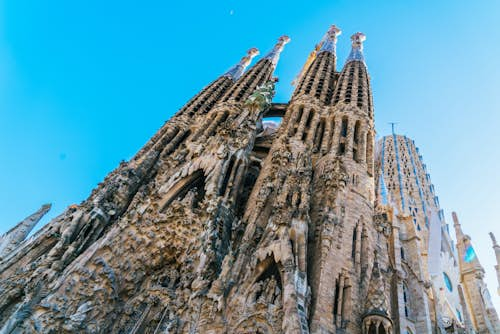
Waiting Times: While a number of factors affect the crowd on any day, the Nativity tower sees a much larger crowd than the Passion tower. This, in turn, affects the waiting time to access the lifts that will take you to the top of the tower.
Architectural Style: The Nativity Facade has a rich history associated with it and was built by Antoni Gaudi himself when he was alive. Most visitors choose to watch the architect’s original work over those who followed the master architect’s set of instructions and designs.
Bridges: While only two towers are accessible at the Sagrada Familia, there is a bridge that connects 2 towers out of the 4 towers on the Nativity Facade.
Construction Status: Nativity Tower offers you beautiful vistas of the Catalan city as its construction is complete. If you are a visitor looking to experience one of the towers for academic purposes, Nativity Tower is your go-to option.
Stairways: According to a majority of visitors, the wider stairs of the Nativity Towers are slightly easier to access than that of Passion Tower. As you are required to climb down 504 stairs, the wider stairs of the Nativity Facade may help if you’re claustrophobic.
Balcony Access: You can stop by the balconies on the stairs for a detailed view of the Towers and peep out to get a bird’s eye view of Barcelona.
Photographs: Most photographers agree that the Nativity Facade offers much better vistas than that the Passion Facade. This is because Nativity Facade provides a brilliant view of the sea over the east of Barcelona, while Passion Facade faces the city center.
Visiting Sagrada Familia
Practical Information
March and October: 9:00 AM to 7:00 PM
April to September: 9:00 AM to 8:00 PM
November to February: 9:00 AM to 6:00 PM
December 25 and 26, January 1 and 6: 9:00 AM to 2:00 PM
After taxis, the Metro is your best option for reaching Sagrada Familia. If you catch a coach on Line 2 and Line 5, you can get down at the Sagrada Familia Station and walk into the top Catalan attraction.
There are quite a few buses which pass through Sagrada Familia. You can board any of the buses 19, 33, 34, 43, 44, 50, 51, B20 and B24 and get down at the Sagrada Familia bus stop to reach the landmark. It should be noted that the main access to the Sagrada Familia is on the Carrer de la Marina (C/Marina).
If you have pre-purchased a ticket and are seeking to enter Sagrada Familia, look for the Nativity facade entrance. Look for black umbrellas near the gate as these entrances are reserved for people with online tickets. If you want to purchase Sagrada Familia tickets, enter from the Carrer de Sardenya road and you'll find a ticket counter there.
If you're coming in a large group or have tickets for a group tour, then your entrance is on Carrer de la Marina. Walk to the ticket office for group visits only. It has to be noted that any party with 10 people or more is considered a group.
Sagrada Familia has a strict dress code that must be followed in its entirety. Since the Basilica is a religious site, make sure you respect Sagrada Familia's dress code.
For safety reasons, no hats are allowed within Sagrada Familia except for religious or health-related reasons. Visitors cannot enter the premises barefoot. Swimwear and skimpy clothes are not allowed. Clothes with plunging necklines, backlines, or exposed abdominal area are not allowed.
Special clothes to celebrate any occasion or for promotional purposes are not allowed. Shoulders must not be visible and shorts and skirts must at least come down to mid-thigh.
Sagrada Familia provides luggage and cloakroom services for free. Over 500 electronic lockers are installed in the left-luggage office, where one can leave their backpacks, bags or luggage safely. Access to your locker is restricted by a card that will only be given to the owner.
Sagrada Familia follows stringent security protocols and it is essential that you make sure to reach a few minutes before your slot. There are walk- through metal detectors and scanners, and you will have to put your bags through the belt as well.
Visitors’ bags, rucksacks, luggage, and personal effects will be inspected at the entrance.
Handy Tips
- While there is an elevator to go up the Sagrada Familia Towers, you have to walk down a spiral flight of stairs. If you're claustrophobic or scared of heights, skip the towers. The tower elevators are stopped during adverse weather conditions, including strong winds.
- The towers cannot be accessed by children below the age of 6 years. All individuals between the age of 6 and 16 years must be accompanied by an adult to go up the towers.
- While choosing which tower to go up on, remember that the Nativity façade faces the East of Barcelona, while the Passion façade faces the city center.
- If you are picking an alternative language for your guided tour, remember to be sure of the timings as they differ from the English guided tours.
- Some tours do not provide audio-guide for children. Be informed about all the exclusions of the tours you pick one.
- Guided Tours of Sagrada Familia and Park Güell begins at Park Güell. If you've opted for this combo, make sure you reach the right meeting point.
- The Sagrada Familia Barcelona entry is free for those who have purchased the Barcelona Pass.
- Both tripod and flash photography are prohibited inside the church. However, with prior permissions and necessary documents, you can indulge in both.
- Hold on to your ticket at all times while you're in the Basilica. There can be random checks.
- Refrain from eating, drinking or smoking on site. They are strictly prohibited.

Sagrada Familia Facts
- Josep Maria Bocabella, a Catalan publisher, visited Italy in 1872 and was highly inspired by the Vatican. Upon his return, he set in motion the plan for building Sagrada Familia. Facing disagreements with the first architect, Francisco del Villar, Bocabella hired Antoni Gaudi a year later as the project architect.
- Antoni Gaudi, who gave 43 years of his life to this iconic structure as the chief architect, was buried in the Our Lady of Mount Carmel Chapel, in the crypt of his masterpiece- Sagrada Familia.
- The construction of La Sagrada Familia, which started in 1882, is expected to be completed by Gaudi’s centennial in the year 2026. By then, its completion will have taken 144 years- which is much more than it took to build the Great Pyramid of Giza in Egypt and the Taj Mahal in India. Some also believe that the structure may take up to year 2040 to complete.
- La Sagrada Familia, once completed, will have a central tower which is 170 meters high (a representation of Jesus Christ), making the Basilica the tallest religious structure in Europe. But it will still be one meter below Barcelona’s highest point, Montjuïc hill. This is because for Gaudi, nature was supreme and it was his belief that no man-made object should reach higher than God’s creation.
- In 1936 when Spain was in the midst of a Civil War, some anarchists broke in and set fire to Sagrada Familia’s crypt. As a result, most of the construction drawings and materials were lost, leaving only enough for the designs to be remade.
- The Church, which is now a Basilica, is designed in a way that it can be viewed from all parts of Barcelona. At its highest points are glass panes, and the light reflected by these are indicators that guide the seafarers home.
- The Basilica has three facades-in the east is the Nativity façade, on the west side is the Passion façade, and in south is the Glory façade. Each of the facades represent important life events and teachings of Jesus Christ. Everything from his passion, death and resurrection, his present and future glory are all depicted here. The 18 towers that are part of the original plan, complete this equation with 12 of them representing the 12 Apostles, the one in the centre represents Jesus Christ-surrounded by four for the Gospels. The star crowned tower above the apse is dedicated to Virgin Mary.
- Gaudi built a school here in 1909 for the children whose parents were building the Church. It was removed recently in 2002 when the Church was expanded.
FAQs
Why is the Sagrada Familia Barcelona so famous?
What are the services available at Sagrada Familia?
How strict is the dress code at Sagrada Familia?
Can you take photos in Sagrada Familia?
What can you see in Sagrada Familia Barcelona?
Which is the best tower to climb?
Can I visit both the towers with a Sagrada Familia Tower ticket?
What year will the Sagrada Familia be finished?
Can I purchase Sagrada Familia tickets online in advance?
Can you buy Sagrada Familia tickets on the day of your visit?
Can I cancel my Sagrada Familia tickets?
Do I need to buy a separate ticket for the Sagrada Familia Towers?
Ready to explore Barcelona?
Check out the top things to do in Barcelona and our all-inclusive Barcelona Travel Guide to plan your vacation like a pro!


